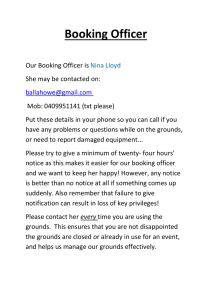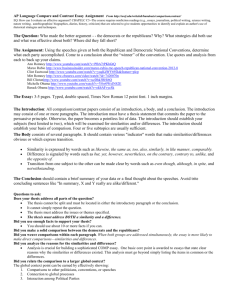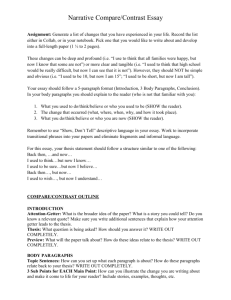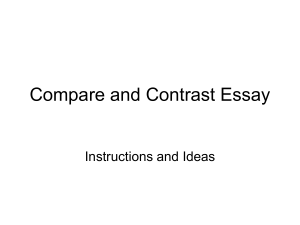The Nature of Comparison
advertisement
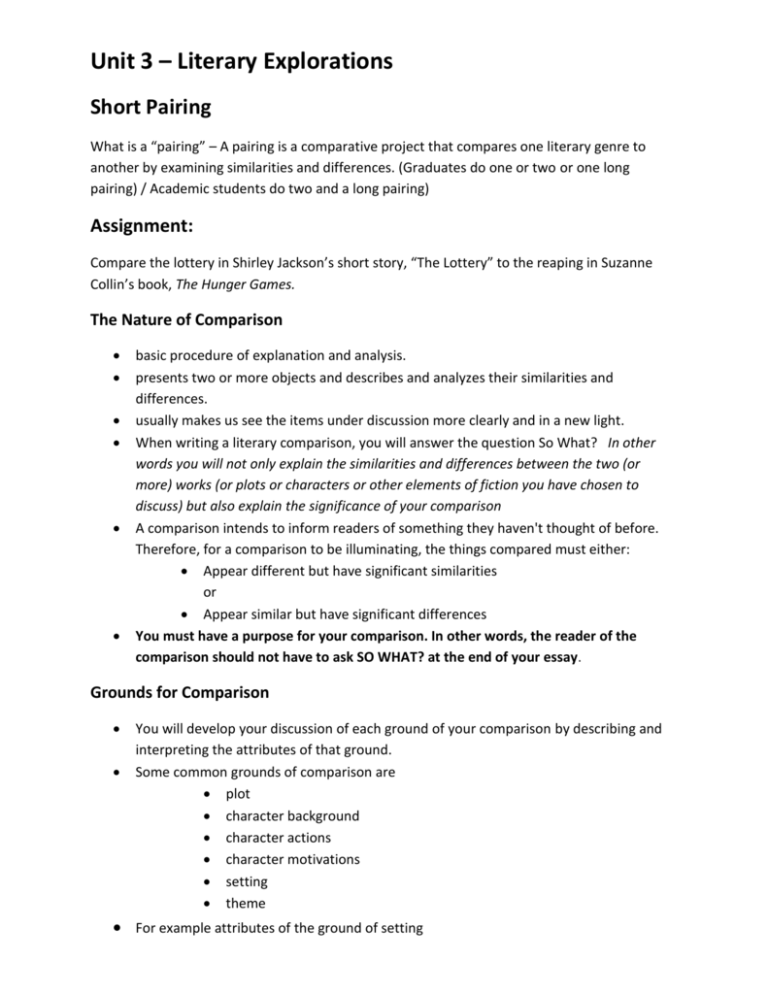
Unit 3 – Literary Explorations Short Pairing What is a “pairing” – A pairing is a comparative project that compares one literary genre to another by examining similarities and differences. (Graduates do one or two or one long pairing) / Academic students do two and a long pairing) Assignment: Compare the lottery in Shirley Jackson’s short story, “The Lottery” to the reaping in Suzanne Collin’s book, The Hunger Games. The Nature of Comparison basic procedure of explanation and analysis. presents two or more objects and describes and analyzes their similarities and differences. usually makes us see the items under discussion more clearly and in a new light. When writing a literary comparison, you will answer the question So What? In other words you will not only explain the similarities and differences between the two (or more) works (or plots or characters or other elements of fiction you have chosen to discuss) but also explain the significance of your comparison A comparison intends to inform readers of something they haven't thought of before. Therefore, for a comparison to be illuminating, the things compared must either: Appear different but have significant similarities or Appear similar but have significant differences You must have a purpose for your comparison. In other words, the reader of the comparison should not have to ask SO WHAT? at the end of your essay. Grounds for Comparison You will develop your discussion of each ground of your comparison by describing and interpreting the attributes of that ground. Some common grounds of comparison are plot character background character actions character motivations setting theme For example attributes of the ground of setting Unit 3 – Literary Explorations Location Year time of year time of day and/or weather. Organization of Comparison Block Method also called Summary Approach or One Side at a Time focus is on items being compared. presents one work, describes all of its relevant grounds and attributes, and then does the same with the second item, using the same grounds for comparison. points of comparison are discussed in terms of the works being compared Advantage--guarantees that each object will have a unified discussion. Disadvantage--points of comparison, because so widely separated in the essay, may be less clear to the reader. Works best when: two objects compared are relatively simple points of comparison are general and few in number amount of information presented is not great Alternating Method Also called element by element or point by point. Focus is on the grounds and attributes of comparison Works being compared are discussed in terms of the grounds and attributes of comparison Advantage--easy to grasp specific points of comparison Disadvantage--might be harder to pull together details and form a distinct impression of what each object is like. Thesis Statement Names the items to be compared Indicates the purpose of the comparison Names the grounds for comparison Thesis Statement Unit 3 – Literary Explorations Sample Thesis Statements Unacceptable I am going to compare the similarities and differences between the films Close Encounters of the Third Kind and E.T., the Extraterrestrial. Acceptable A close examination of the way that Roy Neary, the protagonist of Close Encounters of the Third Kind, and Elliott, the protagonist of E.T., the Extraterrestrial, react to their encounters with aliens demonstrates that director Steven Spielberg uses both films to tell similar stories about the difficulties of growing up. Sample Thesis and Outline with Explanations Comparative Transition Words: contrast, by the same token, conversely, instead, likewise, on one hand, on the other hand, on the contrary, rather, similarly, yet, but, however, still, nevertheless, in contrast Example: The children were very happy. On the other hand, and perhaps more importantly, their parents were very proactive in providing good care. Conclusion would: tie together both sides of the comparison and contrast restate the major impression left by the discussion convince the reader that I have fulfilled my purpose lets the reader know I have finished my essay How to Get Started Reread the assignment. Choose the works you want to compare. Skim the works and review. Choose your grounds for comparison Answer the question So What? by determining a purpose for making this comparison. Gather information and evidence from each work to describe and support each grounds for comparison. Outline your essay. Choose the pattern for organization – block or alternating Compose your thesis. Manuscript Preparation Revise your essay for clarity and style; pay particular attention to transitions between paragraphs. Edit your essay for spelling, grammatical, and mechanical errors. Edit your quotations for accuracy and punctuation. Use APA format (parenthetical references) to cite all references to the texts. Add a References page



